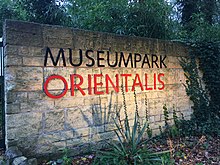Orientalis Museum Park
Museumpark Orientalis (also Oriëntalis ) is the name of a Dutch theme park that introduces Christianity , Judaism and Islam . Until 2007 the name was Bijbels Openluchtmusem (Biblical Open Air Museum ). The park is located near the Heilig Landstichting (Holy Land Foundation) settlement in Berg en Dal near Nijmegen, near the German border.
history
The park was created in 1911 in a wooded landscape. A Catholic priest wanted to replace believers who could not travel to Palestine . Monks explained the time of Jesus in or near reconstructed houses . In later times the organization was improved and the park expanded; however, the construction of a huge basilica had to be abandoned for lack of money. However, the Zönakelkirche was completed .
In 1968, the park was expanded to include Judaism and was subsequently renamed Bijbels Openluchtmuseum by H. Landstichting (Holy Land Foundation) . The missionary nature of the park gave way to a broader representation of the culture of the treated time. Islam was added in 1993. Points of contention in the re-establishment of the park were the extent to which the diocese concerned had a say and how financial participation from Oman should be assessed.
Buildings and grounds

The visitor first reaches the main building, in which a multimedia show is shown. It deals with issues such as religious tolerance and religious rigor. The main building was originally intended to be part of the planned basilica. The recommended hiking route then leads to Nazareth , which is a Jewish village from the time of Jesus. The Islamic part of the park includes a caravanserai , i.e. an inn and next to it a facility for dromedaries . A little further on is a village by a pond that can be reminiscent of the Sea of Galilee . In the middle of the park there is a large area of sand with Bedouin tents .
The original core of the park was Christianity. For example, while the Calvary is no longer in the park, the Via Orientalis is now the Christian counterpart to Judaism and Islam. This is a Roman street with adjacent buildings, including an early Christian church, but also an Egyptian temple.
Some rooms in the villages or on the Via Orientalis show a historical facility, others were artistically designed with reference to the three religions. There are two restaurants in the park and some performers in costume, such as B. an Arab storyteller in the caravanserai.
gallery
criticism
From 2001 to 2009 the number of visitors fell from 120,000 to 70,000 a year, wrote Hélène van Beek in the Trouw newspaper . The Catholic visitors in particular stayed away. At the same time, costs rose, partly due to expensive multimedia shows in the old buildings. For donors, the large number of supporting foundations was overwhelming. The museum itself lived on project-related subsidies, criticized Georgy Schardijn, former head of department at Orientalis, and the director was not able to handle money. According to Van Beek, money from the province for the renovation of buildings could not be requested because Orientalis could not prove its economic viability. There was also no provincial subsidy for the cultural infrastructure because construction work had not started.
Web links
- Official website (Dutch, German, English)
supporting documents
- ^ Hélène van Beek: Het zwarte gat van Oriëntalis; Altijd maar discussie over subsidies Museum Park. In: Trouw - de verdieping , February 26, 2011, pp. 30/31.
Coordinates: 51 ° 48 ′ 49.7 " N , 5 ° 53 ′ 18.1" E








